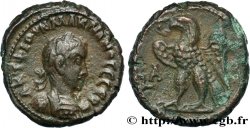v16_0660 - AURELIAN Aurelianus
MONNAIES 16 (2002)
Starting price : 95.00 €
Estimate : 180.00 €
Realised price : 95.00 €
Number of bids : 1
Maximum bid : 120.00 €
Starting price : 95.00 €
Estimate : 180.00 €
Realised price : 95.00 €
Number of bids : 1
Maximum bid : 120.00 €
Type : Aurelianus
Date: novembre 274 - septembre 275
Mint name / Town : Thrace, Serdica (Sofia)
Metal : billon
Millesimal fineness : + 50 ‰
Diameter : 23 mm
Orientation dies : 6 h.
Weight : 3,68 g.
Rarity : R2
Officine: 3e
Emission: 8e
Coments on the condition:
Exemplaire sur un flan très large, complet des deux côtés. Magnifique revers. Jolie patine marron
Catalogue references :
Obverse
Obverse legend : IMP AVRELIANVS AVG.
Obverse description : Buste d’Aurélien, tête radiée, à droite, avec cuirasse, vu de trois quarts en avant (B).
Obverse translation : “Imperator Aurelianus Augustus”, (l’empereur Aurélien Auguste).
Reverse
Reverse legend : RESTITVT OR-BIS/ *// KA..
Reverse description : Pax (La Paix) (?) drapée, debout à droite, tendant une couronne de la main droite à Aurélien lauré, en habit militaire, debout à gauche, tendant la main droite et tenant une haste de la main gauche.
Reverse legend : G.
Reverse translation : “Restitutor Orbis”, (Le Restaurateur du Monde).








 Report a mistake
Report a mistake Print the page
Print the page Share my selection
Share my selection Ask a question
Ask a question Consign / sell
Consign / sell
 Full data
Full data














